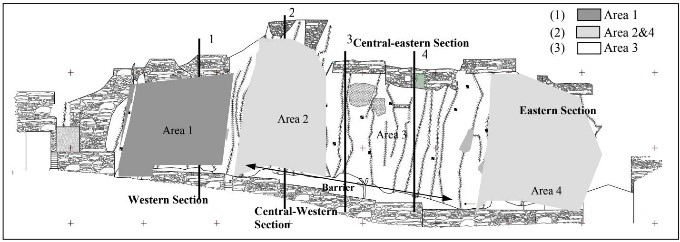
Project Summary/Scope:
Mythimna Castle, located on Lesvos Island in Greece, sits on a foundation of rock with multiple instabilities. Three discontinuity sets form wedges or columnar blocks, and while they don’t jeopardize the stability of the castle itself, the instability of the slope puts the houses underneath in danger. These discontinuity sets create kinematically controlled instabilities and many rockfalls, with a toppling failure mode coming from wedge failures.
The steepest slope is 60 degrees while the others are between 46-50 degrees in angle. Some of the slopes (specifically the eastern one) extend overtop of some of the houses, and stabilization measures needed to be created for the western slope after it was damaged during heavy rainfall.
For the geological scope of the island, there are tertiary sediments and loose sand in the lowlands, and the fault system strikes in a NE-SW and NW-SE direction. The angle of sliding friction was determined to be between 34 and 44 degrees, and the slope angles range from 46 degrees to 60 degrees. When assessing the problems, it was determined that hydrostatic pressure was not a current concern, but could become one with the introduction of heavy rainfall and prolonged water clogging.
The kinetic instabilities present here are wedge failures, local toppling of large blocks, and rockfalls of medium blocks by the undermining of bedding planes. In the western section, two joint sets caused the predominant kinematic instability and most of the toppling of large blocks. In the central-western section, loss of support among the bedding planes caused rockfalls due to the opening of joints and loosening of surrounding rock. In the central-eastern section, there was immense fracturing and weathering, which undermined bedding planes and caused rock falls.
Finally, the eastern section, whose irregular rock face caused overhang due to weathering.
The solution chosen to solve these instabilities was steel protection netting anchored with fully grouted 4m rock bolts. A 3m by 3m grid was used for the western section, while a 4m by 4m grid was used for the central-western and central-eastern face. A limited number of rock bolts were installed in other locations based on the size of the unstable blocks.
Complementary Technologies Used:
40 meters of rock fall fencing was installed to protect property from any rock falls that persist after reinforcement measures.
Alternate Technologies:
Alternatives discussed were hand scaling and sealing discontinuities with grout.
Additional Photo:

Additional Photo or Drawing:

Case History Author/Submitter:
P. Marinos, M. Kavvadas, G. Tsiambaos & H. Saroglou
Geotechnical Engineering Department,
National Technical University of Athens, Athens, Greece
Project Technical Paper:
Marinos, P., Kavvadas, M., Tsiambaos, G., & Saroglou, H. (2002, June). Rock slope stabilization in Mythimna castle, Lesvos island, Greece. In 1st European Conference on landslides, Balkema, edited by: Rybar Stemberk & Wagner, Prague (pp. 635-639).
Date Case History Prepared:
January 2021
